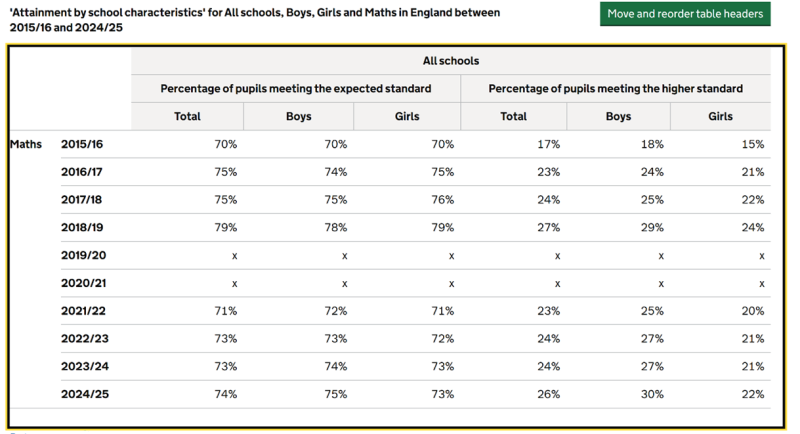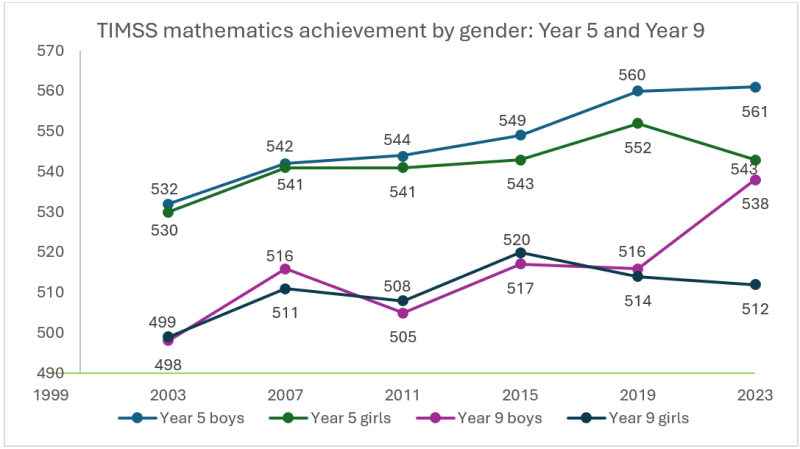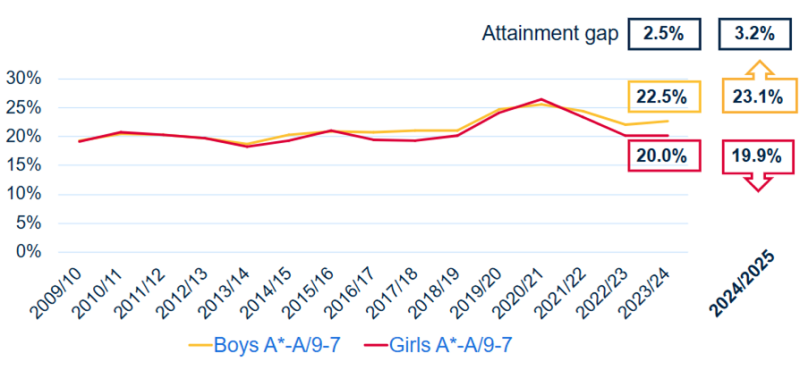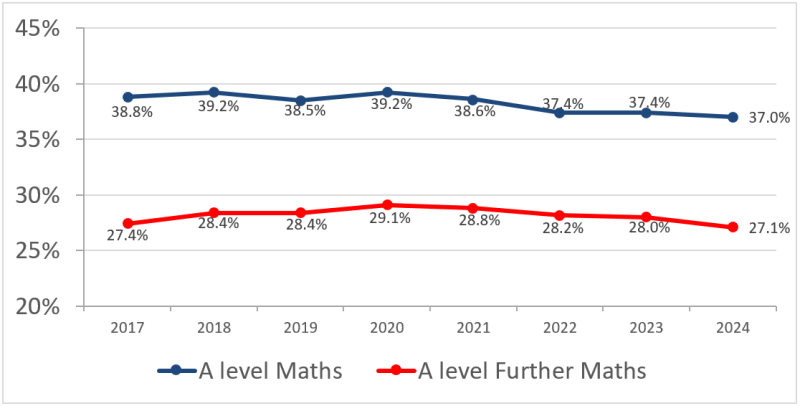Rebalancing the equation: the maths gender gap and why it matters
Charlie Stripp explores the gender gap in maths attainment between boys and girls, and why it matters for girls’ future opportunities, social equity and the nation’s overall potential
09/10/2025

Recent national data highlight a clear and concerning trend: boys consistently outperform girls at higher levels of maths attainment at KS2, GCSE and A level. The data also suggest that the maths gender gap is growing. At A level, there is also a large and persistent gender gap in participation in A level Mathematics (roughly 40% girls:60% boys) and Further Mathematics (roughly 30% girls:70% boys).
These gaps are concerning because:
- Cognitive research shows there is no innate reason why boys achieve more highly than girls in maths, but gaps grow once children start schooli.
- Higher-level maths qualifications, and A level Mathematics in particular, convey significant benefits, including a lifetime earnings premiumii, so this under-representation contributes to the gender pay gap.
- There is a shortage of people in the labour market with STEM and other maths-dependent skillsiii which are crucial to our economyiv.
It’s hard to avoid the conclusion that our maths education system may be letting girls down, with consequences that reach beyond the classroom. The causes are not obvious, but culture is likely to be a factor.
Do we, as parents, teachers or even children themselves, still associate maths with being a boy's subject, believing it more important for boys to succeed? If so, could this bias be influencing the attainment gap?
Gender gaps opened up considerably in England’s maths performance in the Trends in Maths and Science Study (TIMSS) international comparison maths tests in 2023. It is not clear why this happened.
- Did lack of classroom interaction and support during the Covid pandemic have a bigger impact on girls than boys?
- Did parents, perhaps subconsciously, place more emphasis on boys’ maths education than that of girls’ when students were not in school?
- Was it both?
- Was it something else?
Tackling the gender gap in maths will take time, understanding and collaboration. Through the work of the NCETM, the Maths Hubs Programme and the Advanced Mathematics Support Programme (AMSP), we must try to find practical solutions to the maths gender gap and put them into action.
Part of the AMSP’s remit is to increase girls’ progression to A level Mathematics and A Level Further Mathematics, ensuring more young women can access the opportunities that studying advanced maths can provide. This year, the AMSP is piloting the fully-funded Girls' Progression Programme with secondary schools, exploring how they can support more girls to continue to study maths beyond GCSE. Raising awareness is an important first step but our ultimate goal must be lasting change.
Teaching for mastery approaches, developed and shared through the Maths Hubs Programme, can also play an important role in supporting girls to feel that maths is a subject where they can achieve highly. The Five Big Ideas at the heart of teaching for mastery — coherence, representation and structure, mathematical thinking, fluency, and variation — build deep understanding and confidence for all students. Evidence indicates that girls often respond particularly well to lessons that value reasoning, collaboration and depth of understanding over speed, and that give sufficient time to explore and explain ideas. These pedagogical principles create inclusive classrooms where every pupil, regardless of gender, feels capable of succeeding in maths and so is more likely to choose to study it further.
If we can help more girls to feel confident, capable and inspired to study maths, we will not only improve individual life chances, we will strengthen our society as a whole.
The data
- Key Stage 2v

At KS2 there is no significant difference between boys’ and girls’ performance at the expected standard, but there is a clear gap at the higher standard, with more boys meeting the higher standard (a score of 110 or more).
- Trends in Maths and Science Study (TIMSS) international comparisonsvi
In 2023, TIMSS results showed that a maths gender gap had opened up in England.

The reasons are unclear, but since the gaps opened up between 2019 and 2023, shifts in the educational environment and wider social contact during the pandemic period may have contributed.
- At GCSE, boys are outperforming girls in the top grades in mathsvii
Percentage of 16-year-olds achieving top GCSE Maths Grades in England

Since the Covid-19 pandemic, the gap has continued to widen. The 2025 GCSE Maths cohort shown here was the same cohort that took the TIMSS tests in Year 9 in 2023.
- At A level, significantly more boys than girls choose to study Maths and Further Maths
Variation in participation in Level 3 maths by gender

Percentage of total entries from female students in England (JCQ data)
- Boys outperform girls in the A* grades in the maths A levelsviii
A level Mathematics:
-
- In 2024, 17.9% of boys taking A Level Maths achieved the A* grade, vs 14.2% of girls.
- In 2025, 18.0% of boys taking A level achieved the A* grade, vs 14.8% of girls.
A level Further Mathematics:
-
- In 2024 29.3% of boys taking A level Further Maths achieved the A* grade, vs 26.5% of girls.
- In 2025 29.3% of boys taking A level Further Maths achieved the A* grade, vs 26.1% of girls.
i Nature (2025): Rapid emergence of a maths gender gap in first grade, P. Martinot, B. Colnet, T. Breda, J. Sultan5 L. Touitou5 P. Huguet6 E. Spelke, G. Dehaene-Lambertz, P. Bressoux & S. Dehaene, https://www.nature.com/articles/s41586-025-09126-4, accessed Sept 2025
ii Adkins, M. and Noyes, A. (2016). Reassessing the economic value of advanced level mathematics. British Educational Research Journal 42(1): 93-116. DOI: 10.1002/berj.3219, https://www.nuffieldfoundation.org/wp-content/uploads/2019/11/REVAMP20Summary201.pdf, accessed Sept 2025
iii Department for Education (2024): Skills England: Driving growth and widening opportunities, https://assets.publishing.service.gov.uk/media/66ffd4fce84ae1fd8592ee37/Skills_England_Report.pdf, Accessed Sept 2025
iv Academy for the Mathematical Sciences: Quantifying the UK economic contribution of the mathematical sciences in 2023, https://www.acadmathsci.org.uk/wp-content/uploads/2024/10/AcadMathSci-22Oct2024-Economic-Contribution-MathSci.pdf, accessed Sept 2025
v Department for Education (2025): Create your own tables on key stage 2 attainment - Explore education statistics - GOV.UK, accessed Sept 2025
vi Department for Education 2024: Trends in International Mathematics and Science Study 2023: England - GOV.UK, accessed Sept 2025
vii Joint Council for Qualifications 2025: GCSE and Level 1, 2 results - Summer 2025 - JCQ Joint Council for Qualifications, accessed Sept 2025
viii Joint Council for Qualifications 2025: A level and Level 3 results - Summer 2025 - JCQ Joint Council for Qualifications, accessed Sept 2025